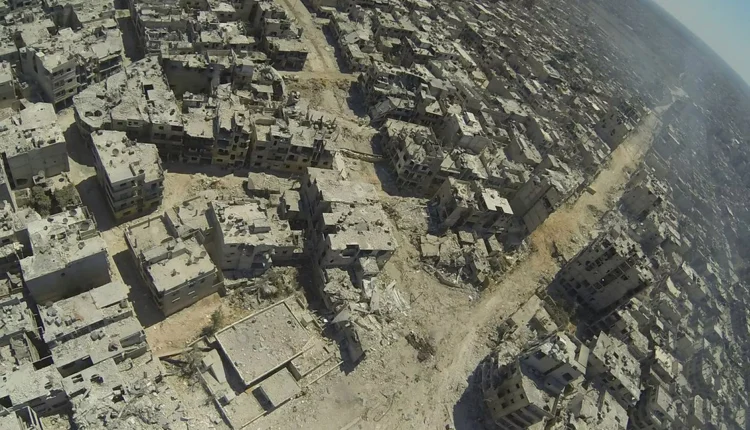
By Emma Jamal
QAMISHLI, Syria (North Press) – The Syrian government fails to rebuild the neighborhoods that it destroyed in the early days of the uprising in Homs Governorate, central Syria, despite dozens of families live in these neighborhoods in ramshackle buildings that may fall at any moment.
Residents of some neighborhoods in Homs, including Karam al-Zaytoon, al-Bayada, al-Kussur, and al-Fa’ur, live in cracked houses, as they cannot purchase or rent new ones. As it is winter, they started doing some simple renovations such as restoring doors and windows in an attempt to protect themselves and their children from cold.
Homs was dubbed the “capital of the Syrian Revolution” after residents embraced the call to overthrow Syrian President Bashar al-Assad in early 2011 and much of the city fell under the control of the opposition.
However, the government forces launched a campaign to retake the city, laying siege to districts they were once home to tens of thousands of people.
The Syrian government deliberately and systematically razed homes, buildings and entire neighborhoods to the ground in Homs using bulldozers and explosives, according to previous reports.
The demolition of those areas is seen as punishment for Syrian civilians protesting against the government or supporting opposition forces. Reportedly, the demolitions were supervised by military forces.
In late 2015, the opposition began evacuating the last district they held, returning the city to the government hands.
Abu Bakr Saqqa, a media activist from al-Khaldiyah neighborhood in the city of Homs, said that those who could get a permission from the security branches of the government forces to get back to their houses were forced to restore their houses by themselves, despite high costs of renovations.
The Syrian government seems not to have a plan to return people to their areas till now, Saqqa told North Press.
People have to get a security approval from the government forces, most of the times from security branches. If the applicant has relatives or friends in the Syrian opposition, he is not allowed to get back.
About 30 percent of the residents of Karam al-Zaytoon, al-Bayada, al-Kussur, and al-Fa’ur neighborhoods returned back to their homes, despite the fact that they are cracked and may collapse at any moment.
Even those who returned to their houses have no access to necessary services, Saqqa added.
He stressed that those neighborhoods suffer from complete absence of services, including hygiene, schools, water, and electricity. Additionally, the people are unable to secure their shares of heating fuel for winter.
In each street, there are over 20 families that are obliged to reside in those houses, as they are unable to buy or rent an adequate house in other areas in the city of Homs.
“Al-Khaldiyah was the symbol of revolution in Homs because the tomb of Khalid ibn al-Waleed is located there and the residents of this neighborhood and Old Homs are Sunnis who started the revolution,” according to Saqqa.
The “regime” has taken over the neighborhood since 2014, however, till the moment, it has not been restored. There are three checkpoints of the government forces controlling the neighborhood, all people have to pass through these checkpoints to get inside or out of it, he noted.
The residents of these neighborhoods have a main role in the protests that broke out in the very early days of the revolution. “The regime carried out the first massacre, in which it killed a thousand people in Homs after only a month of the protests. Since then, the revolution has turned out from a peaceful uprising to armed one,” according to the activist.
The government is punishing the people of those areas by prohibiting them from returning home or not renovating their houses, because most of the residents protested at the beginning of the uprising to overthrow “the Syrian regime.”
The residents of these areas work as employees or workers for living, most of their children have stopped attending schools to go to work, attempting to help their families.
According to obtained information, the people applied requests to councils affiliated to the government to help them in renovating their houses, however, these attempts from the people were in vain, as they get nothing but promises from the government that does not seem to have a plan to renovate houses it destroyed about ten years ago.
